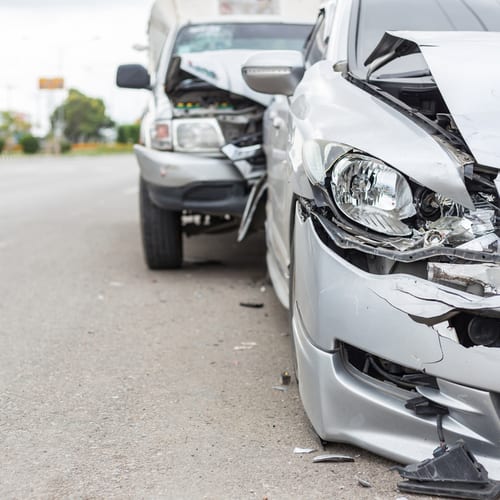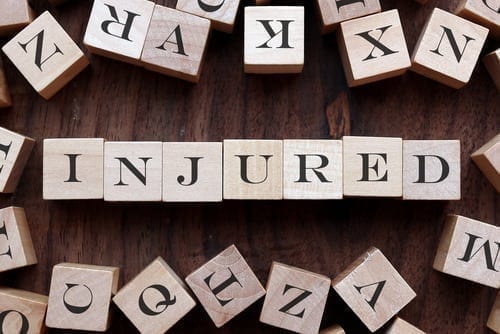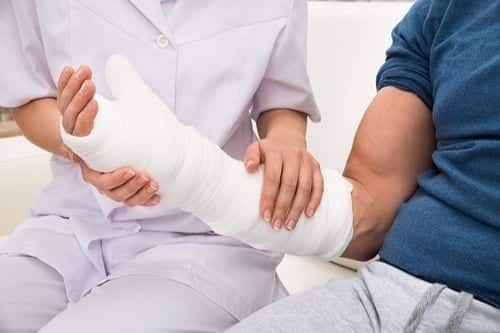
Unfortunately, as of 2023, there are almost 46 car accidents and 17 car accident injuries per day in Raleigh. This post discusses Raleigh Car Accident Injuries.
The Bishop Law Firm represents Raleigh Car Accident Injury victims, and we offer free case reviews. There is no fee unless you win.
Call us today, 919-615-3095, or start your free case review online now.
Types of Raleigh Car Accidents
In Wake County from 2019 to 2023, there was an average of 93 deaths, 11,643 injuries, 234 pedestrian injuries, 74 bicycle accidents, and 239 motorcycle accidents per year (NC DOT).
The Raleigh Police Department has maintained a Raleigh map of car crashes reported since 2015. This map is based on the DMV-349s (accident reports) completed for each reported accident.
This map logs contributing circumstances to Raleigh car accidents, including driver actions: disregarding yield/stop/other traffic signals; exceeding speed limit and failing to reduce speed; improper turns; improper lane usage; failure to yield right of way, and more (NC DOT).
The above unsafe movements can result in (National Safety Council) angle collisions, head-on collisions, rear-end collisions, and sideswipes.
Also read Raleigh Car Accident Reports and Raleigh Car Accident Statistics.
The type of car accident you are involved in can affect the type of injuries you sustain.
Angle collisions cause the most significant number of deaths (about 8,700 in 2023) (via NSC).
Head-on collisions, collisions with much larger vehicles, and T-bones can cause more injury than a rear-end collision or sideswipe.
Car accidents involving pedestrians and motorcycle riders can even prove fatal.
Also read Twenty Tips to Avoid Raleigh Car Accidents & Twenty Steps to Take After Raleigh Car Accident.

Types of Car Accident Injury
There are four main types of car accident injury (physical): soft tissue, broken bones, catastrophic, and fatal. Car accidents can also cause mental and emotional injuries.
Injuries range from mild to fatal.
Also read: How much will my car accident injury settlement be?
Soft Tissue Injury
Soft tissue injuries involve contusions, sprains, tendonitis, bursitis, and strains (per JH).
Pain immediately after your motor vehicle accident, swelling, bruising, and difficulty moving the injured body part are all symptoms of a soft tissue injury (via RUH).
A car crash victim should seek emergency medical treatment to rule out more severe internal injuries.
Soft tissue trauma is among the most common car accident injuries.
Bruises
Skin bruising occurs when blood vessels beneath the skin are damaged (skin remains flat with bruise discoloration).
The skin discoloration from a bruise is due to trapped blood under the skin (MNT).
Many of our clients have chest injuries (bruising) from their seatbelt across their chest after a car accident.
A hematoma is a more severe form of bleeding under the skin and may require drainage.
Hematomas are more painful and raised (VWH).
Whiplash
Whiplash injuries are soft tissue injuries that affect neck muscles, tendons, and ligaments.
Symptoms from whiplash include neck pain worsened by movement, loss of range of motion in the neck, headaches, tenderness, numbness/tingling in the arms, shoulder pain, and dizziness (Mayo Clinic).
Rear-end car accidents cause whiplash (neck injuries) (via LVHN).
Treatment of Soft Tissue Injury
Soft tissue injuries usually heal within six weeks, but can take months to have a complete resolution of symptoms. R.I.C.E., anti-inflammatories, and physical therapy are often recommended.
Car accident victims with soft tissue injury are often involved in low-speed/low-impact collisions (side swipes, rear ends), but that is not always the case.
A victim can be involved in a serious accident and walk away (luckily) with only soft tissue injury.
That being said, a car crash victim involved in a low-speed collision can also walk away with severe injuries under the wrong circumstances.
Also read Skin Injury after Car Accident, Delayed Symptoms After Car Accident, Neck Injury After Car Accident.
Broken Bones

Speed, location of impact, and vehicle size all determine how strong the effect will be during a car accident.
Head-on collisions and T-bones are types of accidents that can cause broken bones, but even a non-severe accident can cause a broken bone, unfortunately.
Crushing force and debris on the inside of your vehicle (even the air bag, steering wheel, and seatbelt) can cause a bone to break.
Knee injuries can occur from direct impact with the dashboard during an auto accident. High-speed collisions can cause crush injuries.
According to AICA, arm, wrist, tibia/fibula, femur, clavicle, rib, back, hip, pelvis, and skull fractures are the most common fractures from car accidents.
Age Affects Healing
As we age, broken bones become harder to mend.
Breaking a bone in a car accident at 50 years of age is a lot different than breaking a bone playing baseball at 10 years old (Read Effects of Aging on Fracture Healing).
Treatment for Broken Bones
Treatment for broken bones depends on the location and type of break. If the bone broke into many pieces (comminuted), recovery will be more difficult.
While broken ribs are painful, they usually heal on their own within six weeks (Mayo Clinic).
Splints, braces, plaster casts, traction, surgically inserted rods, pain relief, and physical therapy are all treatment options.
Read: Back Injury After Car Accident, Shoulder Injury After Car Accident, Leg Injury After Car Accident, Foot Injury After Car Accident.
Catastrophic Injury
Unfortunately, accidents with 18-wheelers, pedestrian accidents, bicycle accidents, and motorcyclist accidents can leave victims with serious injuries, chronic pain, and long-term disabilities.
Catastrophic injuries usually happen when a victim is involved in a crash with a much larger (heavier) vehicle.
In pedestrian, bicycle, and motorcycle accidents, victims do not have the same protection as someone riding in a vehicle.
According to Forbes, types of catastrophic injuries include spinal cord injuries resulting in paralysis, amputation, loss of hearing/sight, facial injury (which causes deformity), nerve damage, traumatic brain injuries, neurological damage, severe organ damage, or severe burns.
Catastrophic injuries will take substantial time to heal, and the victim may never be the same.
Treatment will involve substantial rehabilitation with accompanying medical expenses, significant missed time from work, and can cause severe emotional strain on a family.
Also read: Chiari Malformation After Car Accident, Blunt Force Trauma to the Head After Car Accident, Brain Injury After Car Accident, Chronic Conditions from Car Accidents.
Fatality
Unfortunately, high-speed automobile accidents, accidents that involve drunk/drowsy drivers, and accidents with unbelted victims can result in fatality.
According to the CDC, in the United States, motor vehicle crashes are a leading cause of death and kill over 120 people every day.
Head injuries are a leading cause of death in car accidents (via NIH).
Penetrating injuries to the brain are the most lethal form of traumatic head injury (via NIH).
Wrongful Death can be devastating for families.
Also read: Raleigh Wrongful Death Lawyer.
Mental and Emotional Injuries
Car crashes can leave a victim with psychological injuries due to physical trauma. Though unseen, emotional injuries can be just as devastating as physical injuries.
Post-Traumatic Stress Disorder
Post-Traumatic Stress Disorder doesn't only happen to veterans.
PTSD can occur to anyone after a highly stressful or terrifying event (Mayo Clinic).
After the trauma of an auto accident, intrusive memories, avoidance, negative thinking, and arousal symptoms can occur.
Vehophobia, which is the fear of driving, can also occur after an auto accident.
Read Post-Traumatic Stress Disorder After a Car Accident and Vehophobia.
What to do after a Raleigh Car Accident Injury
- After an accident, always call 911 and report motor vehicle accidents. If you do not report the accident, the at-fault party can say that the accident did not occur.
- Be courteous to the at-fault party. Mistakes happen, and you do not want to take any action that will diminish your position as a victim.
- Take photos of your car and the at-fault parties' car if you can at the scene.
- Seek immediate medical treatment after the accident or tell the officer you need EMS.
- Follow all medical advice.
- If you are in pain, you need to report that pain to your medical providers and also inform them about when the pain started.
- Take photos of your bodily injuries when the accident first occurred and also throughout the healing process. Pictures of injuries speak volumes!
- File a claim with the at-fault party's insurance company.
- Please obtain a copy of the accident report from the police officer who was at the scene or the agency that they work for. Also read Raleigh Car Accident Reports.
- Verify that the police report is correct about what happened. If the police report is not accurate, you will need to contact the officer.
- Decide if you need a Raleigh Car Accident Lawyer to help with your case.
Also read: What not to do after a Raleigh Car Accident.
How can a Raleigh Car Accident Lawyer help?

If you are wondering what a Raleigh Car Accident Lawyer can do for your injury claim or if you even need to hire a car accident lawyer, we are here to give you some food for thought.
Watch: Raleigh Accident Lawyer: Seven Reasons Why You Need One.
The main thrust of what a Raleigh Car Accident Lawyer does is to increase the value of your claim. While a car accident attorney can sometimes get substantial increases in value, other times only modest value increases are made, and even then, only through long-fought litigation.
Either way, the attorney will do all that they can to get you the most money in your pocket because Raleigh Car Accident Lawyers are contingent fee lawyers. Which means that their attorney's fee is based on how much they recover for you.
Also read What does a Raleigh Car Accident Lawyer Do?
If you are looking for a Raleigh Car Accident Lawyer, give us a call today, 919-615-3095, or start your free case review online now.

